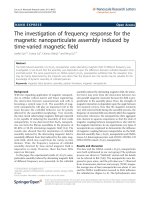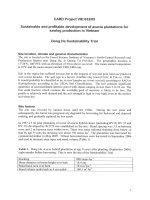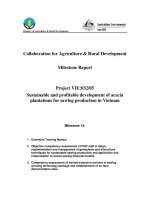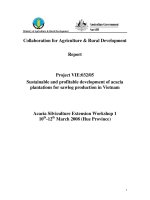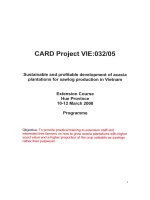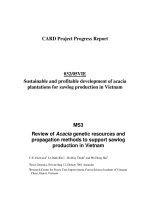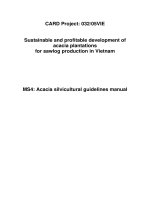Investigation of fermentation conditions for Candida bombicola ACTT22214 from molasses and soybean oil for sophorolipid production
Bạn đang xem bản rút gọn của tài liệu. Xem và tải ngay bản đầy đủ của tài liệu tại đây (1.13 MB, 13 trang )
50
Nong Lam University, Ho Chi Minh City
Investigation of fermentation conditions for Candida bombicola ACTT22214 from
molasses and soybean oil for sophorolipid production
Tho P. Le1∗ , Huong T. T. Le1 , Hiep M. Dinh2 , & Hue B. T. Nguyen1
1
Faculty of Biology and Biotechnology, University of Science, Ho Chi Minh City, Vietnam
2
High-Tech Agriculture Park, Ho Chi Minh City, Vietnam
ARTICLE INFO
Research Paper
Received: October 18, 2018
Revised: December 02,2018
Accepted: December 14, 2018
Keywords
Antibacterial
Candida bombicola
Fermentation
Sophorolipid
Surfactant
∗
Corresponding author
ABSTRACT
Sophorolipid (SL) is a biosurfactant belonging to the glycolipids group and was produced by harmless Candida bombicola
ACTT22214 and has been widely used in many fields in our life. In
order to search for appropriate condition for C. bombicola fermentation producing SL with high efficiency, this study focused on the
investigation of the soy oil concentration, molasses concentration,
fermentation time, pH and temperature. SL products were tested
for antimicrobial activity, antioxidant, emulsifier, foaming ability.
The highest content of SL was 43.27 ± 0.30 g/L under conditions
of: soybean oil content 5%, molasses content 150 g/L, fermentation
time 7 days, pH = 5, 280 C fermentation temperature. The antibacterial activity of SL was good: the highest resistance to Candida
albicans (16.33 ± 1.15 mm), good resistance to Bacillus spizizenii
(13.67 ± 0.58 mm), resistance to Staphylococcus aureus (12.67 ±
1.15 mm), relatively weak resistance to Pseudomonas aeruginosa
(11.33 ± 0.58 mm) and Escherichia coli (9.67 ± 0.58 mm). The
antioxidant capacity of SL was quite high with an IC50 value of
6.024 mg/mL. The emulsifying capacity of SL was equivalent to the
emulsification of the tween 20 at a concentration of 5 – 10 mg/mL.
SL had the ability to foam evenly from concentrations of 5 to 20
mg/mL but not higher than the corresponding concentrations of
tween 20, SL was smooth, even, stable longer than tween 20.
Le Phuoc Tho
Email:
Cited as: Le, T. P., Le, H. T. T., Dinh, H. M., & Nguyen, H. B. T. (2018). Investigation of
fermentation conditions for Candida bombicola ACTT22214 from molasses and soybean oil for
sophorolipid production. The Journal of Agriculture and Development 17(6), 50-62.
1. Introduction
sary strategy. Microbiologically synthesized surfactants, including sophorolipid produced by ferSurfactants are bipolar compounds reducing mentation of C. bombicola are considered due to
surface tension between liquids with liquids, sophorolipid application and commercialization
solids or gases, therefore they are able to com- potential, and significantly because sophorolipid
bine and dissolve in water or other liquids. Most are produced by non-pathogenic and safe C.
used surfactants are originally from petroleum bombicola (Bogaert et al., 2011) which performs
and chemically synthesized, these compounds high productivity (Dubey et al., 2013).
are environmental hazards because of their low
Sophorolipid are glycolipid biological surfacbiodegradability and high toxicity when dissolved tants, they are bipolar molecules formed by one
in water (Bogaert, 2008). Thus, searching for disaccharide sophorose group bonding hydroxyl
replaceable biological surfactants is a necces- group of the second-to-last carbon atom in the
The Journal of Agriculture and Development 17(6)
www.jad.hcmuaf.edu.vn
51
Nong Lam University, Ho Chi Minh City
C16 - C18 fatty acid chain. For the production of sophorolipid by the fermentation of C.
bombicola, two main substrates are provided: hydrophiliccarbon source: glucose and hydrophobic carbon source: fatty acids, oil, fatty acid ester, alkan. There are two types of sophorolipid:
free acid form and lactone ring (Bogaert et al.,
2007). This difference results in distinction in
sophorolipid physical and chemical characteristics, acidic sophorolipid show foaming ability and
high solubility, otherwise, sophorolipid with lactone rings show antibacterial activity and reduce
surface tension effectively.
Sophorolipid are used in food, medicine, cosmetics, detergents (Bogaert et al., 2007). Recent research provided some particular applications of SL. Sophorolipid are used in washing
powder as a detergent (Gobbert et al., 1984).
Sophorolipid emulsification is utilized in petrochemistry. They are used in recovery of secondary
petroleum products, removing hydrocarbons in
crude petroleum. Sophorolipid are used in treating hydrocarbon contaminated soil and water, absorbing heavy metals in sediment and improve
the quality of flour in food industry (Gobbert et
al., 1984; Mager et al., 1987; Daniel et al., 1998).
Sophorolipid perform antibacterial activity in
pimples , dandruff and body’s smell treatment,
protect skin and hair, stimulate metabolism of
epithelial fibroblast cells and synthesis of collagen for skin (Gorin et al., 1961; Cooper & Paddock, 1984). Sophorolipid also inhibit free radicals and aging elastase enzyme, promoting skin
healing and whitening (Isoda et al., 1997). Diacetyl lactone SL can kill carcinoma cell lines such
as liver cancer cell line H7402, decrease mortality rate due to septic shock in lab rats (Kim et
al., 2005; Daverey & Pakshirajan, 2009), inhibit
the development of leukemia cells (Spencer et al.,
1970).
For industrial production and commercialization, SL must be competitive with chemical surfactant in 3 main perspectives: cost, uses and
yield. Therefore, searching for low-cost material
and setting up procedure for producing SL effectively are important. This study investigates
appropriate conditions for C. bombicola fermentation in producing SL from molasses and soybean oil, in addition to conducting test of physical, chemical and biological characteristics of obtained SL.
www.jad.hcmuaf.edu.vn
2. Material and Methods
2.1. Material
Lyophilized C. bombicola ATCC 22214 was
provided by professor Kim Eun-Ki, Inha University, South Korea. Strain was grown in YM
Broth (glucose 1%, yeast extract 0.6%, peptone
0.5%); 2,2-diphenyl-1-picrylhydrazyl (DPPH),
1’,4”-sophorolactone 6’,6”-diacetate were provided by Sigma (St. Louis, USA). Organic solvent: methanol, ethyl aceate, petroliumether were
provided by Xilong company (China). Soy oil content 89.9% (Simply brand) was produced by Cai
Lan vegetable oil company; molasses content 55%
were provided by Kim Minh company; tested bacterial strains were provided by the Research Center of Bioactive Natural Products – University of
Science, Ho Chi Minh City.
2.2. Methods
2.2.1. Propagation of Candida bombicola before fermentation
Lyophilized C. bombicola was propagated in
YM media, after 48 hours, primary culture was
sub cultured, producing secondary culture; C.
bombicola propagation conditions include: temperature of 280 C and shaking speed at 180 rpm
in 48 hours. Secondary culture was used for fermentation and experiments.
2.2.2. Experiments for investigating appropriate conditions for Candida bombicola
fermentation producing sophorolipid
Five one-factor experiments were randomly designed to investigate conditions including: molasses content, soybean oil content, temperature,
pH and fermentation time (sophorolipid obtaining time) (Figure 1). Media used in these experiments contain: yeast extract 0.5%; KH2 PO4
0.1%; MgSO4 .7H2 O 0.05%, CaCl2 .2H2 O 0.01%;
NaCl 0.01%; peptone 0.07%. These experiments
were conducted under conditions of shakingspeed at 180 rpm and fermentation medium
was inoculated with 5% (v/v) seed medium. Erlenmeyer flasks (250 mL) with 50 mL of media were used in the above experiments. Crude
sophorolipid yield was observed.
The Journal of Agriculture and Development 17(6)
52
Nong Lam University, Ho Chi Minh City
Experiment 1:
- Molasses content: 0; 50; 100; 150; 200 g/L.
- Soybean oil content: 5%, pH: 5, 280 C, fermentation time: 7 days
Experiment 2:
- Soybean oil content: 0; 2.5; 5; 7.5; 10%
- Molasses content: 100 g/l, pH: 5, 280 C, fermentation time: 7 days
Investigated
factors
Experiment 3:
- Temperature: 26, 28, 30, 32, 340 C
- Molasses content: 100 g/L, soybean oil content: 5%, pH: 5, fermentation
time: 7 days
Experiment 4:
- pH: 3; 4; 5; 6; 7
- Molasses content: 100 g/L, soybean oil content: 5%, 280 C, fermentation
time: 7 days
Experiment 5:
- Fermentation time: 1; 3; 5; 7; 9 days
- Molasses content: 100 g/L, soybean oil content: 5%, 280 C, pH: 5
Figure 1. Experiments for investigating appropriate conditions for C. bombicola fermentation producing
sophorolipid.
The Journal of Agriculture and Development 17(6)
www.jad.hcmuaf.edu.vn
53
Nong Lam University, Ho Chi Minh City
2.3. Sophorolipid separation from fermented
broth and analysis of obtained SL by thin
layer chromatogrphy TLC
20), the experiment was repeated 3 times.
2.3.1. Sophorolipid separation from fermented
broth
Testing of antibacterial activity was conducted
using agar diffusion method. Bacterial strains:
Escherichia coli, Staphylococus aureus, Bacillus
spizizenii, Pseudomonas aeruginos were inoculated in LB agar plates and Candida albicansin
SD agar plates with paper disks were placed on,
20 µL SL (100 mg/mL) was added to paper disks
and incubated 370 C in 1 – 2 days. Inhibition zones
were observed.
2.4.3. Antibacterial activity
Ethyl acetate (EtAc) was added into culture
broth (1:1 v/v, twice), then centrifuged (6,000
rpm in 5 minutes), supernatant was collected and
vacuum dried in rotary evaporatorat 400 C to remove EtAc. After that, Petroliumether: Methanol
(1:1 v/v, twice) was added and collect the lower
layer (crude SL and methanol), then vacuum
dried in rotary evaporator at 400 C to remove 2.4.4. Free radical scavenging activity
methanol, crude SL was weighed (Figure 2).
Free radical scavenging activity was
2.3.2. Analysis of obtained SL by thin layer determined
using DPPH (2,2-diphenyl-1chromatogrphy TLC
picrylhydrazyl) assay. Crude SL was dissolved in
methanol into different concentrations, 100 µL
Crude sophorolipid was spotted on chormatog- of each sample was added into 96-well plate, 100
raphy plate then immersed in solvent sys- µL DPPH 300 µM was then added and mixed.
tem containedchloroform:methanol: H2 O (80:10:2 The plate was incubated at 370 C in 30 minutes,
v/v/v) in 30 minutes. 1’,4”-sophorolactone 6’,6”- then OD was measured at 517 nm wavelength.
diacetate was used as the standard. After elution, The percentage of free radical scavenging was
the plate was sprayed with acid sulfuric 90% and calculated as the formula: % antioxidant = (1 dried at 1000 C, the spots were visualized.
OD sample/OD control) x 100.
2.4. Sophorolipid activity analysis
2.4.1. Emulsification test
Sophorolipid was diluted in DMSO 5% solution into different concentrations then add 5mL
of each sample into test tubes (diameter: 1.6 cm,
height: 16 cm). Add the same volume of diesel
into these tubes then vortex in 2 minutes, leave
for 10 minutes and observe emulsification after
10 minutes, 12 hours and 24 hours, measure the
height of emulsified layer, emulsification index after 24 hours was calculated as the formula: E24
= (height of emulsified layer/total height) x 100.
2.4.2. Foaming ability of SL
Sophorolipid was diluted in DMSO 5% solution
into different concentrations. After that, add the
same volume of 10 mL of each sample into test
tubes (diameter: 1.6 cm, height: 16 cm), tight the
caps and shake the tubes vertically in 1 minute
then leave them for a while. Foaming was observed, and height of foam layers was measured
after shaking and after leaving for 5 minutes. Repeat the same procedure or the control (tween
www.jad.hcmuaf.edu.vn
3. Results and Discussion
3.1. Morphology of C. bombicola
C. bombicola was recovered and grown in YM
media after 2-day inoculation at 280 C. Culture
was diluted into concentration of 10−9 and inoculated on YM agar plates, the colonies showed
creamy color, smooth and glistening dome shape
with entire margin, the diameter was from 0.4 0.7 cm. Observing under microscope using 100X
objective lens showed the elongated oval shape of
C. bombicola and its budding reproduction (Figure 3).
3.2. Testing of appropriate conditions for C.
bombicola fermentation producing SL
Recovered C. bombicola was grown in YM media in 2 days at 280 C, with 180 rpm of shaking speed to obtain the concentration of 109
CFU/mL. This culture was used as seed medium
for below experiments.
The Journal of Agriculture and Development 17(6)
54
Nong Lam University, Ho Chi Minh City
Fermented broth
Upper layer:
ethyl acetate
(Sophorolipid + oil)
Ethyl acetate (1:1, v:v)
Lower layer: water
(medium + cells
biomass)
Centrifuged in 5 mins, 6,000 rpm
Supernatant:
ethyl acetate +
sophorolipid + oil
Pellet: cells and
impurities
Vacuum dried
Brown layer:
sophorolipid
Yellow layer: excess oil
Petrolium Ether: Methanol (1:1, v:v)
Lower layer: methanol
(Sophorolipid)
Upper layer: Petrolium
Ether (excess oil)
Vacuum dried
Crude sophorolipid
Figure 2. Procedure of separating sophorolipid from fermented broth.
Figure 3. Morphology of yeast C. bombicola. (a) C. bombicola observed under microscope with 100X objective lens shows oval shape and budding reproduction, (b) C. bombicola colonies on YM agar plates after
48-hour incubation at 280 C.
dia was composed of 150 g/L. The results were
shown the difference from the media composed of
100 g/L was not significant. When increasing the
molasses concentration to 200 g/L, SL producC. bombicola was respectively inoculated into tion decreased. It was probably due to the high
testing samples containing molasses contents of osmosis pressure caused by the high concentra0; 50; 100; 150, 200 g/L. The result showed that tion. Therefore, the growth and development of
the highest SL production of C. bombicola was C. bombicola were affected in the adapting stage
43.27 ± 0.31 g/L when the fermentation me- (Table 1).
3.2.1. Investigation of molasses content affecting the fermentation of C. bombicola
producing SL
The Journal of Agriculture and Development 17(6)
www.jad.hcmuaf.edu.vn
Nong Lam University, Ho Chi Minh City
55
www.jad.hcmuaf.edu.vn
C. bombicola was respectively inoculated into
testing samples containing soybean contents of 0;
2.5; 5.0; 7.5, 10%. The results showed the highest
yield of SL was 42.27 ± 0.31 g/L at 5% of soybean content. However, there was no significant
difference from the media containing the soy oil
concentration of 7.5%. On the other hand, when
increasing the amount of soy oil to 10%, SL production decreased significantly. This was probably due to the lower density of soy oil compared to
water and its indissolubility in water. Therefore,
the high concentration disrupted the diffusion of
oxygen in the media (Table 2).
Sophorolipid (g/L)
a-d
Average values followed by letters were statistically significant difference by LSD0.01 test.
200
38.33b ± 0.83
Molasses content (g/L)
50
100
150
c
a
33.33 ± 0.50 41.87 ± 0.64 43.27a ± 0.31
0
d
0.33 ± 0.12
Treatments
Table 1. Investigation of molasses content affecting the fermentation of C. bombicola producing SL
3.2.2. Investigation of soybean content affecting the fermentation of C. bombicola
producing SL
3.2.3. Investigation of temperature affecting
the fermentation of C. bombicola producing SL
C. bombicola was respectively inoculated into
testing samples for fermentation at the temperature 26; 28; 30; 32; 340 C. The results showed
the highest yield of SL was 41.87 ± 0.53 g/L at
the temperature of 280 C. At 340 C, SL yield was
nearly none because C. bombicola was almost unable to grow so the production of SL was stopped
(Table 3).
3.2.4. Investigation of pH affecting the fermentation of C. bombicola producing SL
C. bombicola was respectively inoculated into
testing samples for fermentation at pH conditions: 3; 4; 5; 6; 7. The results showed the highest
yield of SL was 42.07 ± 0.53 g/L at pH = 5.
We found that there was no significant difference
from the result when pH = 6 (Table 4).
3.2.5. Investigation of product obtaining time
affecting the fermentation of C. bombicola producing SL
C. bombicola was respectively inoculated into
testing samples for fermentation with obtaining
time 1; 3; 5; 7; 9 fermenting days. The result
showed the highest SL concentration (41.67 ±
0,61 g/L) when the obtaining time was after 7
days. The SL production decreased significantly
after 9 days of producing because when the substrate became exhausted, C. bombicola would
use SL as a nutrient source. Therefore, the inThe Journal of Agriculture and Development 17(6)
Nong Lam University, Ho Chi Minh City
56
Temperature (0 C)
28
30
32
41.87a ± 0.31 41.00a ± 0.72 36.53c ± 0.61
10
38.53b ± 0.61
34
0.20d ± 0.00
Table 3. Investigation of temperature affecting the fermentation of C. bombicola producing SL
Treatments
26
38.40b ± 0.53
Average values followed by letters were statistically significant difference by LSD0.01 test.
Sophorolipid (g/L)
a-d
Soybean content (%)
2.5
5.0
7.5
31.20c ± 0.72 42.27a ± 0.42 41.00a ± 0.20
Table 2. Investigation of soy content affecting the fermentation of C. bombicola producing SL
Treatments
0.0
13.40d ± 0.53
Average values followed by letters were statistically significant difference by LSD0.01 test.
Sophorolipid (g/L)
a-d
www.jad.hcmuaf.edu.vn
The Journal of Agriculture and Development 17(6)
57
Nong Lam University, Ho Chi Minh City
appropriate SL obtaining time decreased the SL
amount significantly (Table 5).
7
37.13 ± 0.76
Therefore, after the above experiments, the appropriate conditions for C. bombicola fermentation producing SL were shown: 150 g/L of molasses content, 5% of soybean oil content, 280 C,
pH = 5, obtaining time is after 7 days of fermentation. From the above data, fermentation of
C. bombicola was conducted, the yield was 43.27
0.30 g/L. SL obtained is brown,viscous liquid
(Figure 4).
41.33
± 0.42
40.13
Sophorolipid (g/L)
Average values followed by letters were statistically significant difference by LSD0.01 test.
bc
Figure 4. Obtained SL from the fermentaion of C.
bombicola.
According to Table 6, SL yield was considered
high (43.27 g/L), higher than results in the research of Asmer et al. (1988), Nguyen et al. (2017)
and Le et al. (2016) which were 34; 21.8 and 14.6
g/L, respectively. However, SL yield was lower
than in research of Cooper & Paddock (1984),
Deshpande & Daniels (1995), and Zhou et al.
(1992) which were 68; 97 and 138 g/L, respectively. The difference in SL yield can be due to different source of substrates, fermenting conditions
as well as the time of obtaining SL. Therefore,
it is important to have further research on optimal conditions as well as appropriate substrate
contents for the fermentation.
3.3. Analysis of obtained SL by thin layer
chromatogrphy TLC
a-d
6
ab
pH
5
a
42.07 ± 0.46
4
3
c
38.87 ± 0.31
Treatments
Table 4. Investigation of pH affecting the fermentation of C. bombicola producing SL
± 0.61
d
➧
Figure 5 shows the existance of 1’,4”- sophorolactone 6’,6”-diacetate in crude SL, proving the
suitability of crude SL extraction in obtaining
SL from fermented broth. In addition, visualized
spots were at different positions showing different
structures of obtained SL.
www.jad.hcmuaf.edu.vn
The Journal of Agriculture and Development 17(6)
Nong Lam University, Ho Chi Minh City
58
Time (h)
120
100
154
168
168
60
168
Max level of SL (g/L)
34.00
68.00
138.00
21.80
14.60
97.00
43.27
Table 6. Comparison of SL production reported by others to our result
Media components (g/L)
Glucose: 100; oleic: 36; yeast extract: 10
Glucose: 100; sunflower oil: 95; yeast extract: 5
Glucose: 100; safflower oil:105
Glucose: 100; catfish fat: 100 yeast extract: 5
Glucose: 100; coconut oil: 100; yeast extract: 5
Glucose: 100; fat: 100
Molasses: 150, soybean oil: 50; yeast extract: 5
References
Asmer et al. (1988)
Cooper & Paddock (1984)
Zhou et al. (1992)
Nguyen et al. (2017)
Le et al. (2016)
Milind Deshpande & Lacy Daniels (1995)
This work
Product obtaining time (days)
3
5
7
5.40c ± 1.25 35.53b ± 1.10 41.67a ± 0.61
9
35.27b ± 0.90
Table 5. Investigation of product obtaining time affecting the fermentation of C. bombicola producing SL
Treatments
1
0.27d ± 0.12
Average values followed by letters were statistically significant difference by LSD0.01 test.
Sophorolipid (g/L)
a-d
www.jad.hcmuaf.edu.vn
The Journal of Agriculture and Development 17(6)
59
Nong Lam University, Ho Chi Minh City
Figure 5. Chromatogram of SL analysis obtained
SL; (C) standard substance (1’,4”-sophorolactone
6’,6”-diacetate), the Rf value is 0.55.
increased. However, at the concentration of 20
mg/mL, the emulsification of SL is very low, almost none; while at concentrations of 5 mg/mL
and 10 mg/mL, the emulsification of SL is almost equivalent to tween 20. The decrease or loss
of emulsification capacity when the concentration
of SL increases is due to SL’s tendency of aggregate into large masses, its contact and dispersion
into the water phase and the oil phase decreases,
sometimes the accumulation was too much, the
SL mass becomes heavier, leading to deposition
to the bottom and making the emulsification not
good.
3.4.3. Examination of antibacterial activity of
SL
In order to determine the antibacterial activity
of SL, aspirate 20 µL of 100 mg/mL SL solution onto paper plates placed on the surface of
3.4.1. Foaming ability of SL
agar containing the tested microorganisms. Positive antibiotics are gentamicin (100 µg/ml) or
To determine the foaming ability of SL, shake terbinafine (100 µg/mL) and negative methanol
test tubes containing SL and 20 tween (control) (90%).
dilutled in DMSO 5% solution into different conBased on Figure 8 and Table 7, it shows that
centrations were shaked vertically in 1 minute, SL is most resistant to C. albicans, followed by
observing and measure the height of foam layer B. spizizenii, then S. aureus, and finally weak retwice: after shaking and after leaving for 5 min- sistance to P. aeruginosa and E. coli. Thus, it is
utes.
possible to conclude that SL is more resistant to
3.4. Testing of physical, chemical and biological of SL
Based on Figure 6, the foaming ability of the
two surfactants SL and tween 20 increased as
their concentrations increased. The amount of
foam produced by tween 20 was much higher
than by SL. After 5 minutes, the amount of foam
formed by the two surfactants was reduced but
negligible, the foam volume was maintained quite
well. At the same time, smooth, uniform, and stable foam produced by SL was formed, relatively
durable compared to the tween 20.
Gram (+) bacteria than Gram (-) bacteria. This
finding is consistent with researches the research
of Kim et al. (2005). The resistance to C. albicans which is a fungus parasitic on human body
of SL proves that SL has the potential to be used
as safe detergent and antiseptic.
Table 7. Results of the ring diameter of sophorolipid
resistance for microorganisms
Microorganisms
3.4.2. Testing the emulsifying ability of SL
B. spizizenii
C. albicans
E. coli
P. aeruginosa
S. aureus
Antibacterial ring
diameter of SL (mm)
13.68 ± 0.58
16.33 ± 1.15
09.67 ± 0.58
11.33 ± 0.58
12.67 ± 1.15
Determination of emulsifying ability of SL was
carried out by uniformly vortexing SL and tween
20 solutions diluted in 5% DMSO solution into
different concentrations in 2 minutes, leave them
to stand still and observe the emulsion. After 10
minutes, 12 hours and after 24 hours, measure the
3.4.4. Investigation of the antioxidant capacheight of the emulsified layer, determine the E24
ity of sophorolipid by DPPH (1,1index of solutions, with E24 being the emulsifying
Diphenyl-2-picrylhydrazyl)
percentage after 24 hours.
Based on Figure 7, the emulsification of both
Add 100 µl of each SL solutions at differSL and tween 20 increased as the concentration ent concentrations into 96 well microplates. Afwww.jad.hcmuaf.edu.vn
The Journal of Agriculture and Development 17(6)
60
Nong Lam University, Ho Chi Minh City
Figure 6. Results of the foaming test of SL and tween 20. (a) SL after shaking, (b) SL after leaving for 5
minutes, (c) Tween 20 after shaking, (d) Tween 20 after leaving for 5 minutes. SL/tween 20 concentrations
were 0; 5; 10; 15; 20 (mg/mL).
Figure 7. Results from emulsion investigations of SL and tween 20. (a), (b), (c) emulsification of SL after
20 minutes, 12 hours and 24 hours; (d), (e), (f) emulsification of tween 20 after 20 minutes, 12 hours and 24
hours. The investigated SL/tween 20 concentrations were 0; 5; 10; 20 (mg/mL).
Figure 8. Antibacterial results of SL with paper disk method, (+): Positive test; (-): Negative test.
The Journal of Agriculture and Development 17(6)
www.jad.hcmuaf.edu.vn
Nong Lam University, Ho Chi Minh City
61
ter adding 100 µl DPPH, incubate at 370 C for References
30 minutes, then determine the color by ELISA
reader and acknowledge the percentage of antioxi- Asmer, H., Lang, S., Wagner, F., & Wray, V. (1988). Microbial production, structure elucidation and biocondant corresponding to each concentration. Thereversion of sophorose lipids. Journal of the American
fore, determination of the expressed curve shows
Oil Chemists’ Society 65(9), 1460-1466.
the relationship between the substance concenI. N. V. (2008). Literature review on microtration and the corresponding antioxidant per- Bogaert,
bial production and application of the biosurfactant
centage of SL.
sophorolipids, microbial synthesis of sophorolipids by
the yeast Candida bombicola. (Unpublished doctoral
From Figure 9, the IC50 value is 6.024 mg/mL.
dissertation). University of Ghent, Ghent, Belgium.
With IC50 value of 6.024 mg/mL, it can be seen
that the antioxidant capacity of SL is quite good. Bogaert, I. N. V., Zhang, J., & Soetaert, W. (2011). Microbial synthesis of sophorolipids. Process BiochemThis can be applied to produce useful antioxiistry 46(4), 821-833.
dants in cosmetic products such as skin lotion,
Bogaert, I. N. V., Saerens, K., de Muynck, C., Develter,
aiming to care and protect the skin.
D., Soetaert, W., & Vandamme, E. J. (2007). Microbial
production and application of sophorolipids. Applied
Microbiology and Biotechnology 76(1), 23-34.
Cooper, D. G., & Paddock, D. A. (1984). Production of a
biosurfactant from Torulopsis bombicola. Applied and
Environmental Microbiology 47(1), 173-176.
Daniel, H. J., Reuss, M., & Syldatk, C. (1998). Production of sophorolipids in high concentration from deproteinized whey and rapeseed oil in a two stage fed
batch process using Candida bombicola ATCC 22214
and Cryptococcus curvatus ATCC 20509. Biotechnology Letters 20(12), 1153-1156.
Figure 9. The graph shows the antioxidant percentages of SL by DPPH.
4. Conclusion
Initially, suitable conditions for fermentation of
C. bombicola for SL production are found to be
quite high at 43.27 g/L with the following parameters: 150 g/L of molasses; 5% of soybean oil, fermentation temperature is 280 C, pH = 5, fermentation time is 7 days. SL product has good antimicrobial properties, antioxidant capacity with an
IC50 of 6.024 mg/mL, the ability to foam, durable
and stable emulsification equivalent to chemical
surfactants. Therefore, it shows the high application potential of SL in this study in areas such as
cosmetics and detergents.
Acknowledgements
The study was funded by the Ho Chi Minh City
Department of Science and Technology.
www.jad.hcmuaf.edu.vn
Daverey, A., & Pakshirajan, K. (2009). Production, characterization, and properties of sophorolipids from the
yeast Candida bombicola using a low-cost fermentative medium. Applied Biochemistry and Biotechnology
158(3), 663-674.
Deshpande, M., & Daniels, L. (1995). Evaluation of
sophorolipid biosurfactant production by Candida
bombicola using animal fat. Bioresource Technology
54(2), 143-150.
Dubey, P., Selvaraj, K., & Prabhune, A. (2013).
Sophorolipids: in self assembly and nanomaterial synthesis. World Journal of Pharmacy and Pharmaceutical Sciences 2(3), 1107-1133.
Gobbert, U., Lang, S., & Wagner, F. (1984). Sophorose
lipid formation by resting cells of Torulopsis bombicola.
Biotechnology Letters 6(4), 225-230.
Gorin, P. A. J., Spencer, J. F. T., & Tulloch, A. P. (1961).
Hydroxy fatty acid glycosides of sophorose from
Torulopsis magnolia. Canadian Journal of Chemistry
39(4), 846- 855.
Isoda, H., Kitamoto, D., Shinmoto, H., Matsumura, M.,
& Nakahara, T. (1997). Microbial extracellular glycolipid induction of differentiation and inhibition of
the protein kinase C activity of human promyelocytic
leukemia cell line HL60. Bioscience, Biotechnology and
Biochemistry 61(4), 609-614.
Kim, H. S., Kim, Y. B., Lee, B. S., & Kim, E. K. (2005).
Sophorolipid production by Candida bombicola ATCC
22214 from a corn-oil processing byproduct. Journal
of Microbiology and Biotechnology 15(1), 55-58.
The Journal of Agriculture and Development 17(6)
62
Le, L. Q., Ngo, D. D., Hoang, K. Q., Nguyen, D. H.,
Nguyen, H. L. H., & Nguyen, H. T. B. (2016). Production and characterization of sophorolipids produced by
Candida bombicola from coconut oil. Science & Technology Development Journal 19(5), 15-25.
Mager, H., R¨
othlisberger, R., & Wzagner, F. (1987). Use
of sophorolse-lipid lactone for the treatment of dandruffs and body odeur. European patent, 0209783.
Nong Lam University, Ho Chi Minh City
Spencer, J. F. T., Gorin, P. A. J., & Tulloch, A. P. (1970).
Torulopsis bombicola sp. Antonie Van Leeuwenhoek
36(1), 129-133.
Zhou, Q. H., Klekner, V., & Kosaric, N. (1992). Production of sophorose lipids by Torulopsis bombicola from
safflower oil and glucose. Journal of the American Oil
Chemists’ Society 69(1), 89-91.
Nguyen, H. L. H., Le, L. Q., Vo, S. T., Le, M. V., Le,
D. V., Phung, H. T. T., Pham, D. V., & Nguyen,
D. H. (2017). Production and characterization of
sophorolipids by Candida bombicola using catfish fat.
Ho Chi Minh City University of Education Journal
of Science 14(9), 152-159.
The Journal of Agriculture and Development 17(6)
www.jad.hcmuaf.edu.vn
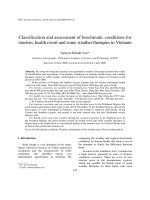
![Báo cáo khoa học: Investigation of the interaction between the atypical agonist c[YpwFG] and MOR docx](https://media.store123doc.com/images/document/14/rc/ht/medium_57MlXT7HZ5.jpg)

